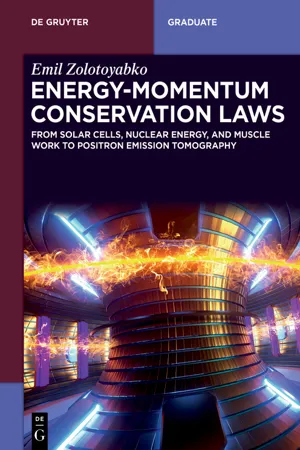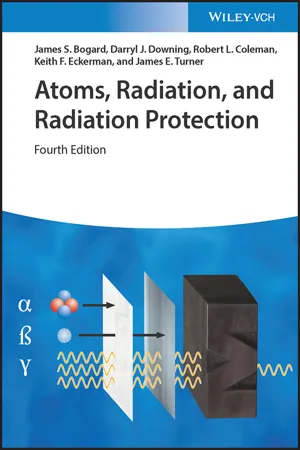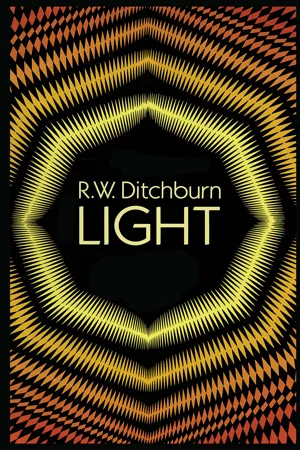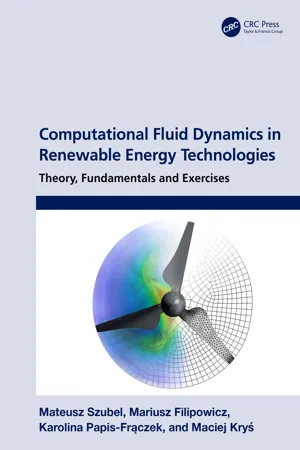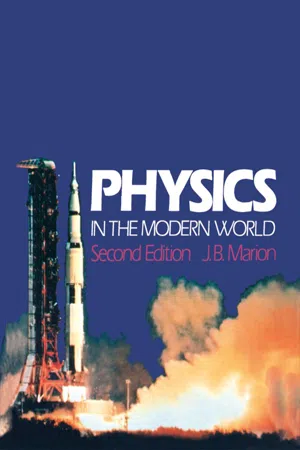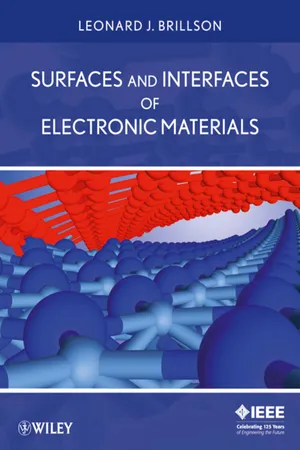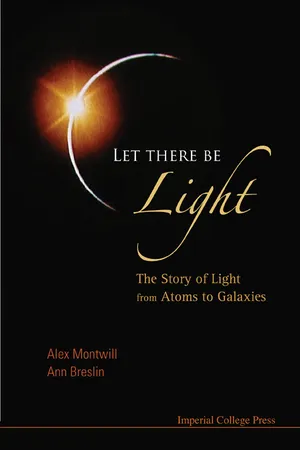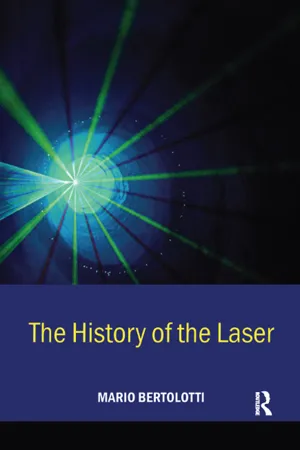Physics
Photoelectric Effect in Photocells
The photoelectric effect in photocells refers to the phenomenon where light, typically in the form of photons, is incident on a material, causing the ejection of electrons. This process generates an electric current, which can be harnessed for various applications such as solar cells. The effect is a key principle in understanding the interaction between light and matter.
Written by Perlego with AI-assistance
Related key terms
Related key terms
1 of 4
Related key terms
1 of 3
9 Key excerpts on "Photoelectric Effect in Photocells"
- eBook - ePub
Energy-Momentum Conservation Laws
From Solar Cells, Nuclear Energy, and Muscle Work to Positron Emission Tomography
- Emil Zolotoyabko(Author)
- 2024(Publication Date)
- De Gruyter(Publisher)
Einstein equation:(5.8)ℏ ω = ℏ= W +2 π cλEk i nwhere λ is the photon wavelength and c is the speed of light in a vacuum. It was indeed a brilliant idea of Albert Einstein, who suggested, just after Planck made his assumption about the discrete nature of black body radiation, that light consists of photons propagating with certain energy and momentum. Equation (5.8) also explained the experiments of Aleksandr Stoletov (performed in 1888), which showed that the photo-current is proportional to light intensity and does not depend on light wavelength if the latter is shorter than some threshold value (dictated by eq. (5.8) for0). In 1921, Einstein was awarded the Nobel Prize in Physics “for his services to theoretical physics, and especially for his discovery of the law of the photoelectric effect.”E=k i nThe photoelectric effect in metals has several useful applications, for example, it is employed for fabricating photocathodes in photomultipliers. Cesium (Cs) is the most often used material in photocathodes since it has the lowest work function, W = 1.95 eV. Electron emission from a Cs photocathode occurs if the incoming photons have wavelengths λ <635 nm. The onset of the photoelectric effect (at maximum wavelength, i.e., at=2 π c ℏWE= 0) is used to extract the work function directly with the aid of eq. (5.8).k i n5.2 Clean energy harvesting and new lighting technologies
Since the last decades of the twentieth century, a real revolution has been developing in the field of clean energy harvesting aimed at pollution reduction by cutting the usage of carbon-based fuels toward general climate improvement on our planet. The utmost importance of this issue was recently emphasized when the 2021 Nobel Prize in Physics was awarded to Klaus Hasselmann and Syukuro Manabe - eBook - ePub
- James S. Bogard, Darryl J. Downing, Robert L. Coleman, Keith F. Eckerman, James E. Turner(Authors)
- 2022(Publication Date)
- Wiley-VCH(Publisher)
Raleigh scattering of a photon results from the combined, coherent action of an atom as a whole. The scattering angle is usually very small. There is no appreciable loss of energy by the photon to the atom, which, however, does “recoil” enough to conserve momentum. We shall not consider Thomson or Raleigh scattering further.The principal mechanisms of energy deposition by photons in matter are photoelectric absorption, Compton scattering, pair production, and photonuclear reactions. We treat these processes in some detail.8.2 Photoelectric Effect
The ejection of electrons from a surface as a result of light absorption is called the photoelectric effect. The arrangement in Fig. 8.1 can be used to study this process experimentally. Monochromatic light passes into an evacuated glass tube through a quartz window (which allows ultraviolet light to be used) and strikes an electrode 1 causing photoelectrons to be ejected. Electrode 1 can be made of a metal to be studied or have its surface covered with such a metal. The current I that flows during illumination can be measured as a function of the variable potential difference V21 applied between the two electrodes, 1 and 2, of the tube. Curves (a) and (b) represent data obtained at two different intensities of the incident light. With the surface illuminated, there will be some current even with V21 = 0. When V21 is made positive and increased, the efficiency of collecting photoelectrons at electrode 2 increases; the current rises to a plateau when all of the electrons are being collected. The ratio of the plateau currents is equal to the relative light intensity used for curves (a) and (b).Experiment on photoelectric effect. With electrode 1 illuminated with monochromatic light of constant intensity, the current I is measured as a function of the potential difference V21 between electrodes 2 and 1. Curves (a) and (b) represent data at two different intensities of the incident light.Figure 8.1When the polarity of the potential difference is reversed (V21 < 0), photoelectrons ejected from the illuminated electrode 1 now experience an attractive force back toward it. Making V21 more negative allows only the most energetic photoelectrons to reach electrode 2, thus causing the current I to decrease. Independently of the light intensity, the photoelectric current drops to zero when the reversed potential difference reaches a magnitude V0 , called the stopping potential. The potential energy eV0 , where e is the magnitude of the electronic charge, is equal to the maximum kinetic energy, Tmax - eBook - ePub
- R. W. Ditchburn(Author)
- 2013(Publication Date)
- Dover Publications(Publisher)
Planck’s original theory was concerned only with the interaction of radiation and matter. He hoped that it would involve only minor modifications of the classical electromagnetic theory of light and the classical electron theory of matter. This expectation was not fulfilled and it became necessary to modify the theory of light to include the fact that energy of the radiation field which represents a beam of light can change only by an integral number of quanta. It is also necessary to assume that an atom can change its energy only by discrete amounts, and hence that atoms can exist only in certain states separated by finite differences of energy. Nothing in the classical laws of electromagnetism, which are based on experiments with static fields or alternating fields of low frequency, would lead us to expect this effect.The quantum theory thus becomes both a theory of radiation and a theory of matter instead of being merely a special hypothesis concerning their interaction. The theory is a connected whole and we cannot deal with a section of the theory concerning radiation without referring extensively to atomic structure. In this chapter we discuss the experimental basis of the quantum theory, giving special prominence to experiments on light and on electromagnetic radiation of shorter wavelength. The order is chosen for convenience of exposition and does not follow the historical order.17.2. The Photo-electric Effect.It is found that electrons are ejected from the surfaces of metals by light and by radiation of shorter wavelength (X-rays and y-rays). If the radiation is able to penetrate the substance, electrons in the interior may be removed from their equilibrium positions. In this paragraph we are concerned with the emission of electrons from surfaces, and we shall call this the photo-electric effect, although, strictly, it should be called the surface photo-electric effect. The number and velocities of electrons emitted have been measured for different metals and for different wavelengths. Fig. 17.1 shows in a diagrammatic way a simple apparatus. Fig. 17.2 shows a more elaborate experiment in which the surface of the metal is freshly cut in vacuo immediately before the measurements are made. The results of the experiments in which monochromatic light is incident normally upon the surface of a metal may be summarized as follows:Fig. 17.1.—Photo-electric effect. Diagram of simplified apparatus - eBook - ePub
Computational Fluid Dynamics in Renewable Energy Technologies
Theory, Fundamentals and Exercises
- Mateusz Szubel, Mariusz Filipowicz, Karolina Papis-Frączek, Maciej Kryś(Authors)
- 2023(Publication Date)
- CRC Press(Publisher)
Part III Photoelectric-Conversion-Based TechnologiesPassage contains an image
10 Theoretical Background
DOI: 10.1201/9781003202226-1310.1 Development of Technology
In Chapter 6 , it has already been explained how to use solar energy to generate electricity by producing heat that can be used to run heat engines connected to generators. This method requires two stages – heat production and heating of the operating medium in the engine or turbine system – and employment of thermal solar collectors (especially with certain concentration technology). Photovoltaic devices are characterized as the ones that can convert sunlight directly into electricity, without the requirement to use any moving components or operating medium.Internal photovoltaic effect that is the basis of a photovoltaic cell operation is the phenomenon of excitation of the electrons in the valence band by photons with sufficiently high energy (according to the quantum theory) and the movement of such electrons to the conduction band in the semiconductor material. The final consequence of the above described effect is generation of the electromotive force.Photoelectric effect was discovered in 1839 by a French scientist, Alexandre Edmond Becquerel. He observed an increase in the conductivity of a lighting system when he was carrying out an experiment with electrodes and an electrolyte. Becquerel was able to examine the impact of different light wavelengths. The best results were observed for the blue and ultraviolet range [1 ]. The first selenium photovoltaic cell was created by Charles Fritts in 1883. It was in the form of a thin selenium layer covered by gold foil. The efficiency of the manufactured cell reached around 1% [2 ].Although the first PV cell based on principles similar to those of the classic modern cells was already constructed in the 1920s, practical applications of photovoltaics appeared only in the early 1970s [3 - eBook - ePub
- Jerry Marion(Author)
- 2012(Publication Date)
- Academic Press(Publisher)
17ELECTRONS AND PHOTONS
Publisher Summary
This chapter explains the phenomenon of photoelectric effect. The photoelectric effect exhibits a frequency limit, and if the frequency is too low, the effect cannot be produced even if the light intensity is made very large. The chapter describes the qualitative aspects of the photoelectric effect. According to classical electromagnetic theory, the energy transferred by a wave is proportional to its intensity and does not depend on the frequency. The chapter discusses the fundamental principles governing the interaction of radiation and matter at the atomic level. It illustrates the interference pattern produced by electrons. Electrons have wave properties and exhibit interference effects. Electron wavelengths tend to be considerably smaller than the wavelengths of visible light. The chapter explains the accumulation of single-photon events on a diffraction screen. A photon can exhibit both wavelike and particlelike properties. The chapter discusses the concept of wave packet and describes quantum theory.At about the time that Einstein was formulating his ideas concerning space and time which were to lead to the development of relativity theory, scientists were also investigating the nature of light and electrons. Electrons were known to be particles and light was acknowledged to be a wave phenomenon.We all have rather clear intuitive ideas about waves and particles. We know that a wave is an extended propagating disturbance in a medium. We know that a particle is an object that can be located at a particular point in space whereas a wave cannot. And we have come to accept the existence of atomic particles–electrons, protons, and neutrons. What could be simpler? A wave is a wave, and a particle is a particle; the distinction is clear.17-1 THE PHOTOELECTRIC EFFECT
The Ejection of Electrons from Metals
But it is not all this simple. As the 20th century began, scientists were confronted with new questions concerning waves and particles. It had been discovered, for example, that if a piece of clean zinc is exposed to ultraviolet (UV) radiation, the zinc acquires a positive charge. The radiation can carry no charge to the zinc, so this result must mean that electrons (the carriers of negative charge) are literally knocked off the zinc by the action of the UV radiation (Fig. 17-1 ). The removal of electrons causes the zinc to become charged positively. This phenomenon is called the photoelectric effect and the ejected electrons are called photoelectrons. - eBook - ePub
- Leonard J. Brillson(Author)
- 2012(Publication Date)
- Wiley-VCH(Publisher)
Chapter 7
Photoemission Spectroscopy
7.1 The Photoelectric Effect
Photoelectron spectroscopy is one of the most widely used surface science techniques. Its utility stems from the discrete or quantized nature of light, first explained by Albert Einstein in 1905 [1] and for which he received the Nobel Prize in Physics in 1921. At the turn of the century, researchers had noticed that light incident on clean metal surfaces resulted in electrons being ejected from the metal surface into vacuum. Significantly, these electrons appeared only for incident wavelengths that were shorter than a critical wavelength. Furthermore, the kinetic energies of these ejected electrons appeared to increase with decreasing wavelength. Finally, this wavelength dependence appeared to be independent of light intensity. Einstein recognized that light could deliver its energy in quantized amounts, analogous to the quantized energies of lattice vibrations in a solid that had been proposed earlier by Planck [2] to account for black body radiation (and for which Planck received a Nobel Prize in 1918). These quantized packets of energy, termed photons, could have an energy(7.1)where h is Planck’s constant, equal to 6.626 × 10−34 J-s, and ν is the frequency of light, equal to the speed of light c divided by wavelength λ. Thus, as wavelength decreases, frequency ν and energy hν increase.Figure 7.1 illustrates these features of the photoelectric effect. In Figure 7.1a , electrons absorb photon energy hν and some are ejected into vacuum. The kinetic energy of these electrons can be measured with a plate biased to retard the collection of electrons leaving the illuminated metal. Here the kinetic energy is just equal to the minimum retarding potential needed to cut off collection of these electrons. Figure 7.1b shows the dependence of the maximum kinetic energy Emax versus photon frequency ν. The kinetic energy is linearly proportional to ν with slope h. The minimum energy required to eject an electron is shown as the extrapolated dashed line and defined as the work function, qΦW - eBook - ePub
- Marc Belleville, Cyril Condemine, Marc Belleville, Cyril Condemine(Authors)
- 2012(Publication Date)
- Wiley-ISTE(Publisher)
4.5 ]4.3. Photovoltaic cell: physical principle and model
4.3.1. Physical principle
A photovoltaic cell is a component that generates electric energy when exposed to light. Photovoltaic cells are based on semiconductor materials, mostly: – bulk monocrystalline (c-Si) or multicrystalline (mc-Si) silicon;– thin films of amorphous or polycrystalline materials: amorphous silicon (a-Si), microcrystalline silicon (μc-Si), amorphous silicongermanium alloy (a-SiGe), cadmium telluride (CdTe), Cu(In,Ga)Se2 (CIGS) ternary chalcopyrite compounds;– thin films of monocrystalline III-V compounds, prepared through epitaxy; and – thin films of organic materials.The operating principle of a photovoltaic cell is outlined in Figure 4.4 .The cell consists of a stack of two semiconductor layers: an n -type layer (in which the main charge carriers are electrons, i.e. negative charger carriers) and a p -type layer (in which the main charge carriers are holes, i.e. positive charge carriers). At such a pn junction, there is a space charge layer, and thus an electric field. When the cell is illuminated, each photon absorbed by the semiconductor creates an electron-hole pair. The electric field at the pn junction separates photogenerated electrons and holes by taking electrons toward the n -zone and the holes toward the p -zone. Illuminating the cell thus generates a current and voltage. Generally speaking, photovoltaic cells are electrically interconnected to form modules. The current and voltage supplied by a module can be adjusted through the number of cells and the interconnection scheme (in parallel or series).Figure 4.4.Photovoltaic cell operational principle. The electric field E at the pn junction separates the photo-generated electrons and holes - eBook - ePub
Let There Be Light
The Story of Light from Atoms to Galaxies
- Alex Montwill, Ann Breslin(Authors)
- 2008(Publication Date)
- ICP(Publisher)
Figure 13.4 .The most energetic photoelectron has an energy eV, just enough to overcome an adverse potential V. Figure 13.4 shows this energy as a function of the frequency of the light shining on the photosensitive surface. According to Einstein's equation it is equal to the energy of the photon minus the work function W, the energy used up by the electron in getting out of the metal.All the experimental data on the photoelectric effect agree with the predictions of one simple equation! Abandoning his former scepticism Millikan conceded ‘this is a bullet-like, not a wave-like effect’. As a bonus, the slope of the graph in Figure 13.4 provides an independent measurement of Planck's constant, h.Note that momentum does not come into play, because the electron is basically attached to the lattice, which is much heavier, and absorbs all the momentum.13.1.9 The photoelectric work functionThe work function W is a measure of the minimum amount of work required to draw an electron out of the metal. It varies from metal to metal, and determines the minimum photon energy required for the photoelectric effect to take place at that metallic surface.The most energetic photons of visible light are at the violet end of the spectrum. It can be seen from the table that such photons have enough energy to liberate electrons from caesium, potassium and sodium, but not from aluminium, copper, mercury or lead.Table 11.1 Photoelectric work function of some elements.An example with numbersWhen light of wavelength 480 nm strikes a photosensitive surface, the emitted electrons have a stopping potential of 0.45 V. What is the photoelectric work function of the metal? (1 eV = 1.60 × 10–19 J)13.1.10 Practical applicationsQuite apart from its theoretical importance, the photoelectric effect has numerous practical applications. It makes it possible to convert a light signal into an electric current. Television cameras, burglar alarms, barcode readers and light sensors of every description are based on the photoelectric effect. - eBook - ePub
- Mario Bertolotti(Author)
- 2004(Publication Date)
- CRC Press(Publisher)
CHAPTER 6EINSTEIN AND LIGHT, THE PHOTOELECTRIC EFFECT AND STIMULATED EMISSION
In June 1905, when Einstein published, in volume 17 of Annalen der Physik, his revolutionary paper Uber einen die Erzeugung und Verwandlung des Lichtes betreffenden heuristischen Gesichtspunkt (On a heuristic viewpoint concerning the production and transformation of light), everybody had been convinced that light was composed of electromagnetic waves. If one thing was certain, that was it. Einstein, however, planted a doubt, and revealed the dual nature of light: both particle-like and wave-like. Although he was rather critical with respect to Planck’s theory, he showed which fundamental conclusions could be derived from it and thus established the crisis of classical physics. At the time Einstein was 26 years old, and his paper appeared in the same volume of the journal in which he published two other fundamental papers: one on statistics, concerning Brownian motion that allowed the old controversy concerning the ‘physical’ existence of molecules to be cleared up, and the other in which he presented the theory of special relativity. All three papers contribute to making this volume of Annalen der Physik one of the most notable in the whole scientific literature.The photoelectric effect
The paper is today commonly referred to as the Einstein paper on the photoelectric effect; however, it bears a much greater meaning. In it, Einstein deduced, from general considerations of statistical thermodynamics, that the entropy of the radiation described by Wien’s distribution law has the same form as the entropy of a gas of elementary particles. Einstein used this argument to reason, from a heuristic point of view, that light consists of quanta, each one having an energy content given by the product of Planck’s constant and the frequency of the light, and applied this conclusion to explain certain phenomena, among which was the photoelectric effect. He wrote:
Index pages curate the most relevant extracts from our library of academic textbooks. They’ve been created using an in-house natural language model (NLM), each adding context and meaning to key research topics.
Explore more topic indexes
Explore more topic indexes
1 of 6
Explore more topic indexes
1 of 4
